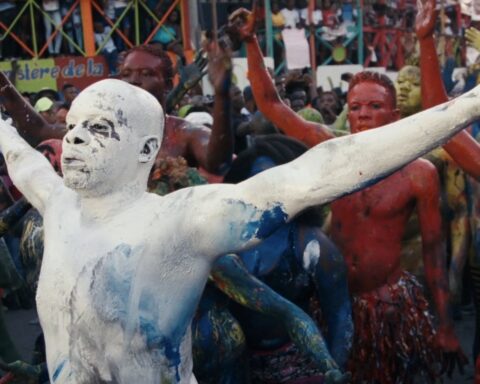Call Me Dancer
(USA, 84 min.)
Dir. Leslie Shampaine; Co-dir. Pip Gilmour
Dance offers a vital pillar of Indian culture. It fuels weddings, celebrations, and the joy of nearly every Bollywood movie. However, one can hardly make a living as a dancer in India unless one lands a gig in the movies. For aspiring dancers like Mumbai’s Manish Chauhan, a film set doesn’t offer the same goalpost as the theatre does. Call Me Dancer follows Manish as he endeavours to soar on the world stage. It’s a dream that his parents reluctantly support, if only he can land an income to sustain them.
As Manish explains to the camera, his father is a taxi driver and his grandfather was a taxi driver. He hails from a working class family of very modest means, but his parents saved up for him to go to school. Their dream is that he’ll ascend the social ladder and provide for the family through new opportunities. However, Manish shares his love for dance and reflects upon how he got to his current crossroads: he’s not a born talent, but a hard worker. Archival clips show the aspiring artist after a Bollywood film introduced him to contemporary dance. Manish flips, leaps, and bends his body with an artist’s skill. Despite being relatively old to begin dance as a late-blooming teenager, he quickly excels.
This beautifully-shot character-driven documentary finds an instant hook in Manish’s pure desire to pursue his passion. Call Me Dancer situates Manish’s plight within the social backdrop/history of India to accentuate the risk he’s taking. In a nation bound by the traditions of the caste system, social mobility is very difficult. Artistic pursuits usually require cushion money that families like Manish’s simply don’t have. Dreams like this one carry a lot of weight for one dancer.
A Mentor and a Rival
Call Me Dancer follows Manish as he puts his studies on hold to take dance classes. His talent and passion impress his teacher, 70-year-old Israeli tutor Yehuda Maor, who truly matches Manish’s dedication. Yehuda sees great potential in Manish, but understands that they’re racing against time as the body offers a relatively brief window for a ballet career. Manish has spent considerable effort trying to convince people that he’s a dancer and not an acrobat, and that dance offers a viable career. He’s finally found someone who believes in him on both fronts.
The film features lots of training sessions as it draws from the fabric of a backstage/underdog drama. Vérité-style footage charts Manish’s growth. Through pliés, jetés, and countless hours working the bar, Manish hones every muscle in his body to excel at dance. However, so too does a new student at the school, Amir Shah, who is seven years Manish’s junior. Yehuda acknowledges that Amir has the innate talent for dance that Manish does not. He nurtures both dancers and uses one’s natural-born talent to fuel the other’s competitive edge. A little jealousy does the dancer good, but Yehuda doesn’t hide the fact that Amir seems far likelier to soar
If Call Me Dancer has a set-up for great drama fuelled by rivalry, though, it doesn’t get to use the ingredients to their full potential. When a once-in-a-lifetime opportunity befalls Amir, his sponsoring company initiates a media blackout. That storyline ends abruptly, but it punctuates Manish’s tale: his window to make a career in dance narrows by the hour.
Infectiously Crowd-Pleasing Drama
Director Leslie Shampaine and co-director Pip Gilmour create an inspiring and highly entertaining underdog tale with Manish’s story. The mentor-protégé relationship between Manish and Yehuda, moreover, offers the heart of the film as Call Me Dancer observes how discipline, dedication, and that one person who believes in you combine to make dreams a reality. The doc also lets Manish’s artistry shine in cinematic interludes that showcase his skills with far more awe that the modest observational footage from the studios, dance school, and very, very sweaty rehearsal space that Yehuda gets for the boys allow.
The film enjoys dramatic ups and downs as Manish lands a gig in the Netflix film Yeh Ballet, which draws inspiration from his journey with Amir. Manish even gets to play a variation of himself in the hybrid drama. It’s an amazing shot at stardom that makes his parents proud, but it brings a conundrum. He could use the film as a big break to dance in movies, but, again, he craves the thrill and pedigree of the stage.
But he also rolls with COVID-related closures to dance studios and performances. The high cost of living and the shortage of paying gigs also give him a reality check as he commits himself to audition after audition, only to land parts that don’t pay. While the film oddly does not seem remotely interested in Manish’s personal life—there’s nary a sense of one—Call Me Dancer honestly captures the level of dedication required to make it as a starving artist. The film also gives credit to donors, patrons, and philanthropists to extend Manish’s story with a message about supporting the arts. It’s something to keep in mind if debating whether to grab a ticket for this—or any—documentary.














